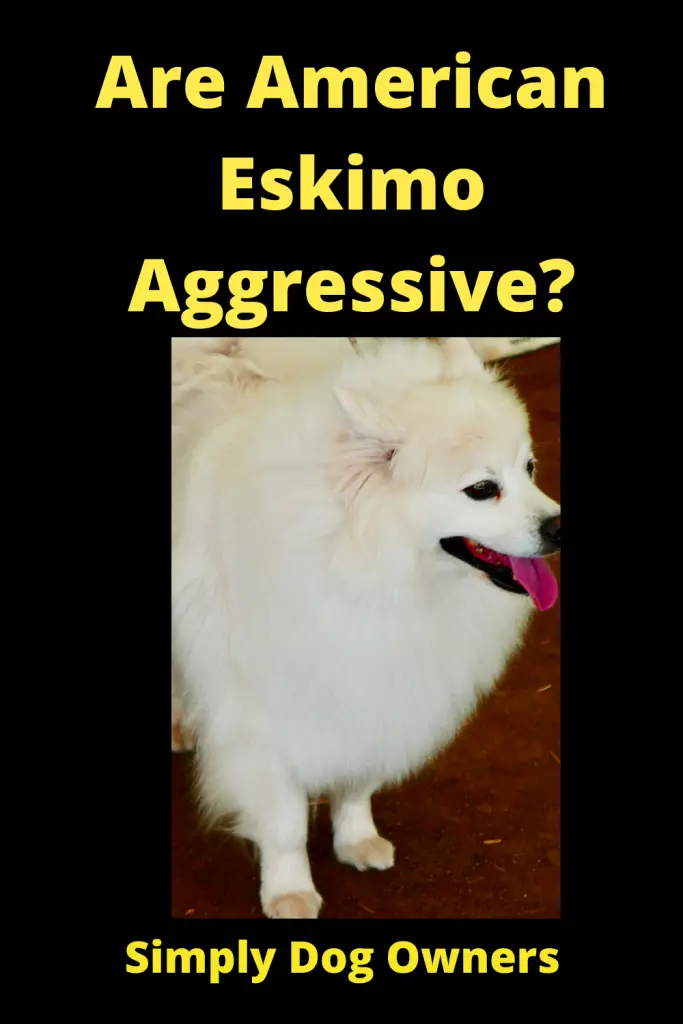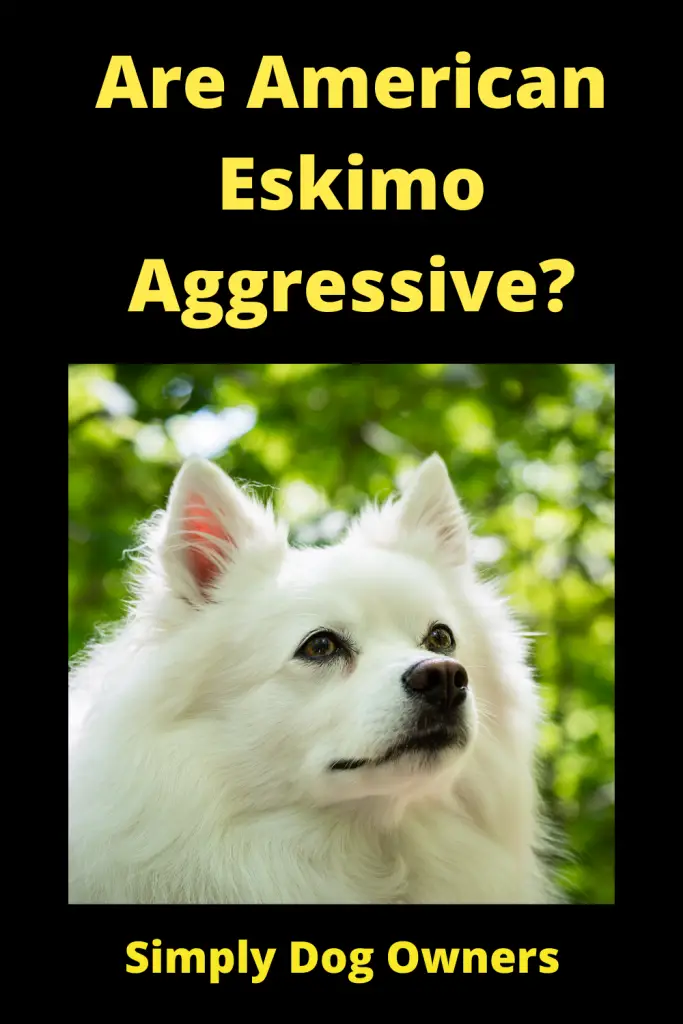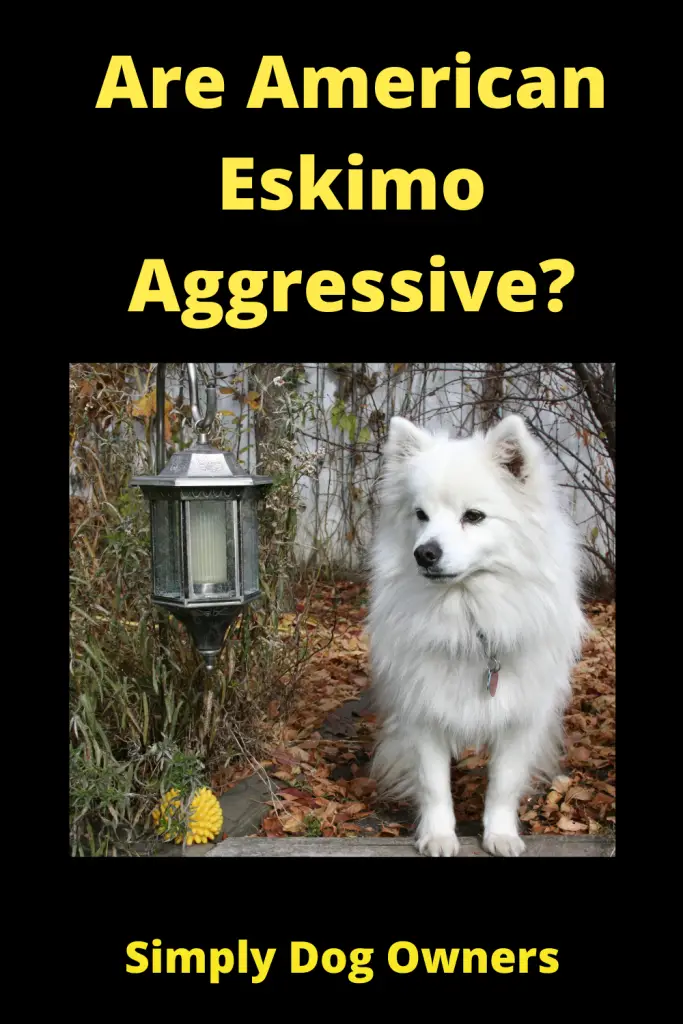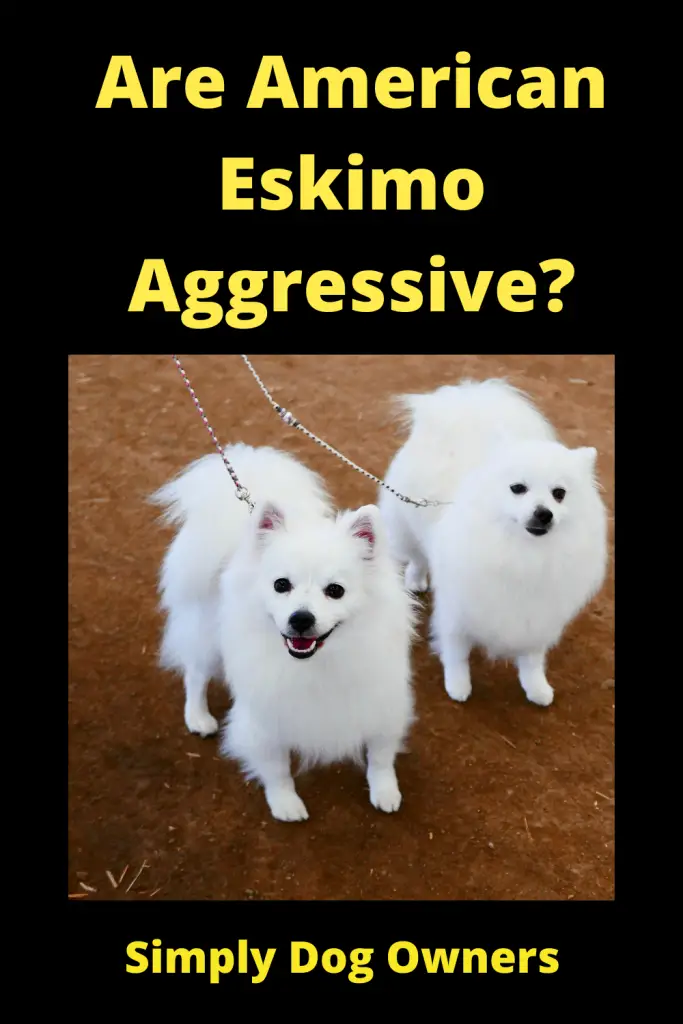Are American Eskimo aggressive?
Are American Eskimos aggressive? The American Eskimo Dog is a white-coated, fluffy dog in three sizes: Standard, Miniature, and Toy. What’s the average size of an American Eskimo Dog? The Standard American Eskimo stands 15-19 inches tall and weighs approximately 30 pounds. The Miniature stands 12-15 inches tall and weighs about 20 pounds. The toy stands 9-12 inches tall and weighs about 10 pounds.
The origins of the Eskie (American Eskimo) are unknown. They are thought to be descended from white Keeshonds, Pomeranians, and German Spitz dogs brought to America by German immigrants. The American Spitz was the original name for the Eskie. The name was changed to American Eskimo in 1917 for unknown reasons.

Eskies are intelligent dogs who were once common in traveling circuses during the nineteenth century. Although the Eskie did not achieve widespread popularity until the latter half of the twentieth century, this helped bring attention to the breed. The American Eskimo Dog Club of America (AEDCOA) was established in 1985. The Eskie was officially recognized ten years later by the American Kennel Club. What kind of dog is an American Eskimo? It’s a “non-sporting dog,” according to the American Kennel Club.
Eskies are energetic dogs who make excellent companions for active people. When properly trained, an American Eskimo Dog can provide years of companionship and enjoyment to a family or a single owner. Continue reading to find out more about this fascinating breed!
Her temperament as an American Eskimo Dog makes her a joy to have as a pet. She’s friendly, intelligent, and easy to train, but younger children may not appreciate her tight hugs. This breed’s protective temperament has been passed down through generations of Eskies, making her an excellent guard dog. Her name is appropriate because her coat is pure white, like snow.
American Eskimo Temperament
There are a few characteristics of the American Eskimo Dog temperament that you should be aware of before deciding whether this is the right dog for you. Continue reading to see if the Eskie is the right dog for you:
She’s Protective
She may jump at the chance to protect you if she senses an impending threat because of her protective nature and long history as a guard dog. However, she will rarely progress to full-fledged aggression. American Eskimo is a breed that barks a lot more than it bites.
Early training and socialization are the best ways to help her manage this personality trait. Bring her to dog parks, long walks, and the homes of your friends who may have dogs. It’s essential to be cautious around strangers, but you should assist her in doing so so that her caution does not turn into suspicion. You don’t want her to grow up to be overly protective to the point where she can’t trust anyone.
She’s Friendly
The fact that the Eskie barks frequently does not make her unsociable. This breed is naturally friendly, and she can be pretty playful. She exudes a certain joie de vivre that is contagious.

She’s Intelligent
Because Eskie is an intelligent dog, she is easier to train. Smart dogs, on the other hand, tend to become bored quickly. If you don’t keep your Eskie busy and entertained, she’ll find her ways to pass the time – which sounds about as scary as leaving a toddler to do the same!
Another disadvantage of an intelligent breed is that they often believe they are smarter than you and can rule the roost. If you’re persistent and consistent in your training, she’ll eventually figure out that you’re the boss around here, not her.
She’s Good at Letting You Know What She Wants
The Eskie is a gifted communicator as well. She shows you what she wants with her eyes. She may, for example, look at her toy before looking at you, indicating that she wants to play.
She Can Be a Barker
American Eskimo can be a bit of a barker due to her protective nature. On the other hand, her intelligence makes it simple to teach her when it’s appropriate to bark and when it’s not.
The Eskie and Children
Although the American Spitz is a friendly dog, she may become irritated if you have young children who aren’t as gentle as you are. Children should be supervised around the Eskie, and they should be taught that tight hugs may not be as friendly to the dog as they may believe.
The American Eskimo Dog with Cats (and other animals)
The Eskie, like many other breeds, gets along better with other dogs and cats if they are raised together. However, certain animals, such as the American Eskimo Dog, should never be around a Nordic breed. Birds, reptiles, and rodents such as hamsters and gerbils are examples of these pets.
American Eskimo Dogs Loves the Water and to Swim
Swimming is one of Eskie’s favorite pastimes. And they can get pretty good at it because their double coat makes them water-resistant, allowing them to swim without getting slowed down
. So, if you’re a swimmer, don’t be hesitant to bring your Eskie along for a swim – she’d be delighted to join you! Being a great swimmer, on the other hand, does not always come naturally to the Eskie.
Eskie, the Circus Dog!
The Eskie had a successful circus career in the late 1800s! American Eskimo was a natural in front of the camera, thanks to her bright white coat and agility for stunts. The Eskie is thought to be the first dog ever to walk a tightrope! Eskies can still perform a variety of tricks with ease today.
Do American Eskimo dogs bite?
Although the American Eskimo Dog is not considered an aggressive dog breed, American Eskimo dogs are often quite vocal, barking at all strangers because of their history as a watchdog.
Adult American Eskimo dogs rarely bite without being provoked. Biting is a favorite pastime of American Eskimo puppies. Biting is an instinct that should be redirected rather than punished in puppies.
Do American Eskimos Bark A lot?
Consider the American Eskimo Dog if you want a breed with a lot to say. This breed is highly vocal, barking, yowling, and even mumbling.
Eskies make excellent apartment dogs if they are walked frequently and given plenty of opportunities for exercise.
So, let’s pretend you’ve decided on the American Eskimo Dog as the best dog breed for you. You have chosen to add an American Eskimo Dog puppy to your family. What criteria will you use to select the best puppy? Let us look at some characteristics of the American Eskimo dog breed to help you find the perfect puppy.
Are American Eskimo Dogs Dangerous?
Most American Eskimo Dogs are reserved around strangers, have keen eyes and ears, and take their watchdog responsibilities seriously, though not to the point of aggression. However, early and frequent socialization is necessary to ensure that their vigilance does not turn into suspicion or irritability.
The majority of American Eskimo Dogs get along with other dogs, but they can be jealous when other animals get all of the attention.
Are American Eskimo Dogs Easy to Train
On average, American Eskimo dogs are intelligent and easy to train. The key to getting your Eskie to listen to you is to train him gently and lovingly. Please don’t make him do something that he doesn’t want to do. Instead, try to persuade him and, if necessary, bribe him with a favorite treat. When your dog does something right during the training process, praise him with your voice and, if desired, feed him a small treat. He’ll remember these movements and be eager to repeat them.
Make sure you’re not using a training collar by itself. When you first start using it, your Eskie will most likely try to get out of it a few times. Take your American Eskimo to an area with no traffic in case he or she decides to flee. The harness and the training collar are always used together.
Both the harness and the training collar should have the same length of the leash. When they’re about to misbehave, lightly tug on the training collar leash. Say “No” at the same time as you tug on the training collar leash. Your Eskie receives a clear message from the leash correction and voice command.
As soon as the bad behavior is about to occur, try to correct it. It’s all about timing the correction, remaining calm, and effectively communicating. We discovered that whispering the commands and lowering the voice works best with our Eskies. They enjoy the unique quality of whispering. It immediately grabs your attention.
Have a good time with the training. Bring your Eskie’s favorite treats with you. When they perform well, lavish them with praise and a treat. Positive support can go a long way toward assisting an Eskie in learning.
Tips for First Time Eskimo Spitz Owners!
- Eskimo dogs do need training, even with their naturally obedient temperament.
- Don’t bathe your Eskie unless their outer coat is genuinely filthy. The natural oils in their double coat will keep them clean – a bath tends to dry out their skin and cause itches.
- The double coat also needs a good brush once a week as American Eskimo dogs shed hair quite a lot!
- Although they look very fluffy and warm, the Eskimo dog needs to stay indoors rather than sleep outside. Just like the Italian Volpino Italiano, more fluff does not equal more warmth!
- Keep a healthy diet to avoid obesity, and keep an eye out for fleas attracted to that magnificent coat. Other health problems in American Eskimo dogs include hip dysplasia and progressive retinal atrophy. There is a low risk of the luxating patella and Legg-calve-Perthes disease, but overall they are a very healthy dog breed.
Can American Eskimo dogs be left alone?
The company of his people is Eskie’s favorite place. Even though an Eskimo Dog can be left alone for up to eight hours, it can become damaging if bored or not given enough exercise. Because barking is a natural behavior for this breed, he may bark if left alone. Barking and dangerous behaviors can be avoided with plenty of exercises and mental stimulation, but crate training may be required.
Can you keep an American Eskimo Dog Indoors?
If they can get outside to burn energy, American Eskimo Dogs make excellent indoor companions. They can adapt to various living situations, including apartments, but the breed’s propensity for barking may cause neighbors problems.
Can you keep American Eskimo dog Outdoors?
An Eskie enjoys being in the great outdoors, as long as he is accompanied. Because this sneaky breed is prone to wandering, a strong recall is essential, and fenced areas may be required. Eskies adore snow and can spend hours playing in it. An Eskie’s personality necessitates that he live indoors with his people, despite being built to withstand inclement weather and enjoys being outside. He may bark, dig, or withdraw excessively if left outside.

Do American Eskimos Bark A lot
The American Eskimo appears to be constantly barking and enjoys the sound of his voice. You listen like a good friend, but eventually, he has to quiet down so you can hear yourself think. Do you think that will ever happen?
Barking is a genetic trait in American Eskimo dogs. The Eskie is fiercely protective of his pack and will attack intruders with his bark. You’re now his pack, and he’s your attentive watchdog because he’s no longer roaming the German hills with packs of dogs and has made his home in your house. If he sees a stranger approaching, he is quick to raise the alarm, making him a rather boisterous dog.
Because Eskie’s hearing is so good, he probably hears potential predators before you do, and you can trust him to warn you. Despite the amount of noise he makes, this dog is not as aggressive as many people believe.
The Eskie’s bark is usually worse than his bite, and unless he’s been trained to be aggressive, you shouldn’t expect him to become aggressive. In terms of friendship, the Eskie has strong bonds with his canine companions and dislikes it when people argue in front of him. Because of his strong bond with you, he is loyal and protective of you and your home, resulting in a lot of barking. On occasion, the Eskie has been reported to howl and mumble in addition to barking.
Because Eskie has a hard time getting along with strangers, he might make a lot of noise when introducing a friend. When he meets someone new, his concern for you, combined with his unfamiliarity with strangers, makes it difficult for him to relax. This boisterous dog is frequently happy and playful, but he requires enough time throughout the day to be entertained and interact with others, whether you, a human friend or another dog. When an Eskie is left alone for too long, it becomes destructive as well as noisy.
Can American Eskimos live in warm climates?
American Eskimos are built for snow and cold, but with care, they can handle hot weather. In the summer, the Eskie’s fluffy coat protects him from the heat and should not be shaved. While Eskies can tolerate some heat, extreme temperatures may be too much for this cool-weather breed. He will require plenty of water, shade, and air conditioning or fans indoors in hot weather or while joining in strenuous activities.
The coat of an American Eskimo can be shaved, but it is not encouraged. This coat insulates the dog in the winter and regulates the dog’s temperature in the summer. Even after the coat grows back, shaving it will harm it. If you believe the coat is too long, the best solution is to cut it to the desired length. However, it is advised that you do not touch the dog’s coat.
Grooming an American Eskimo Dog
- Before bathing your American Eskimo dog, brush him with a pin brush to remove mats and snarls. Eskies have a dense undercoat and a stiff, wiry topcoat with a thick double coat. To avoid hair breakage and static electricity, lightly spray his coat with water. Sweep the pin brush all over your American Eskimo in the direction of hair growth, then brush against it, starting at the back of his thighs and working your way forward to his head. This brushing technique ensures that his coat is sufficiently detangled for a thorough bath.
- Brush sensitive or difficult-to-reach areas with a slicker brush. Slighter knots and snarls than a pin brush can softly be found behind the ears, among the legs, and under the tail of an Eskie.
- Bathe your American Eskimo by holding the water nozzle close to his skin and thoroughly wetting his coat and skin. The water can then seep into his undercoat through his water-resistant outer coat. Apply dog shampoo, being careful not to get shampoo in his eyes, ears, or mouth. To confirm that the shampoo reaches the skin, part his fur in several places. Rinse with warm or lukewarm water thoroughly.
- Fill a plastic jug halfway with lukewarm water and add 2 or 3 tablespoons of conditioner. Pour the diluted conditioner over your dog’s entire body to moisturize his skin and coat, massaging the conditioner in. Rinse thoroughly and pat dry with a clean towel until damp.
- Brush your dog once more to get rid of any tangles leftover from his bath. Sweep the pin brush over his whole coat and use the slicker brush to reach hard-to-reach areas.
- If desired, trim your American Eskimo’s paws. For cleanliness, the breed standard allows trimming between the paw pads and around the paw’s top. Trim any extra hair from between the paw pads and snip the hair around the paw in small amounts with thinning shears. Use a nail clipper to snip or grind his nails.
- Brush your Eskie’s teeth once a week at the very least. Apply a small amount of toothpaste considered for dogs to your index finger with a finger toothbrush. To remove plaque buildup, gently brush his teeth and gums.
Do American Eskimo dogs like to cuddle?
When each family wants equal lap time, American Eskimo dogs typically bond with just one family member, which can be a problem. However, there is a reason why the American Eskimo dog breed is becoming increasingly popular. It’s simple: they’re adorable and cuddly.
American Eskimo Dogs are one of the world’s most lovable dog breeds! These dogs are cuddly and sweet, and they form strong bonds with their human families. However, in addition to their love of cuddling, American Eskimo Dogs require a lot of exercise.

Are American Eskimo Dogs Good Hunting Dogs
Despite not being a hunting dog, American Eskimo Dogs have a keen nose and a high prey drive to do well in barn hunt events.
Final Thoughts
Her temperament as an American Eskimo Dog makes her an excellent watchdog, but she is not aggressive. Don’t be fooled by her quick barking; it doesn’t mean she doesn’t like you. When she’s in protector mode, she’s simply protecting her human. Otherwise, she’s just saying hello! Although the Eskie is a healthy breed, she is prone to eye and hip problems. As a result, before investing in an Eskie puppy, make sure you thoroughly research your breeder.
